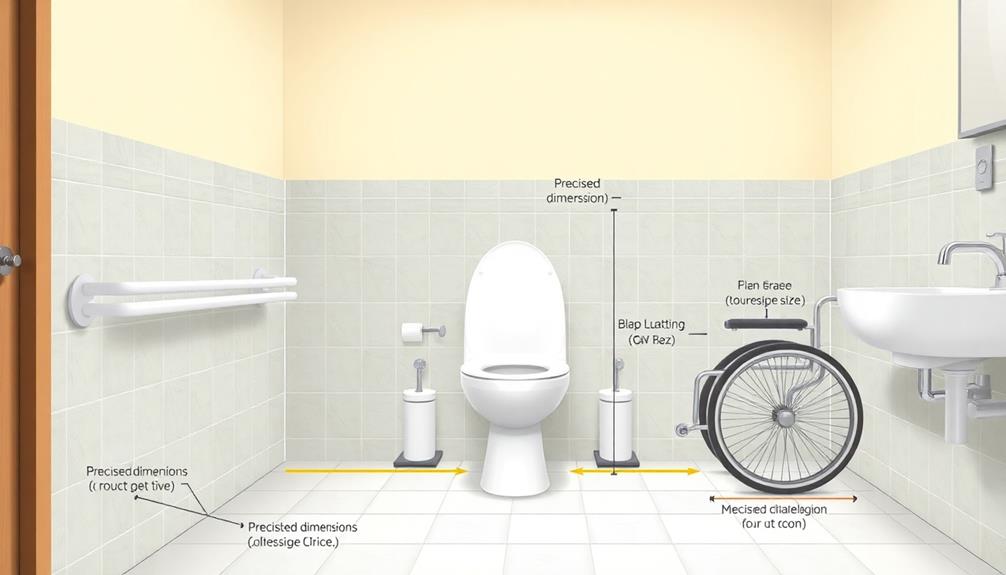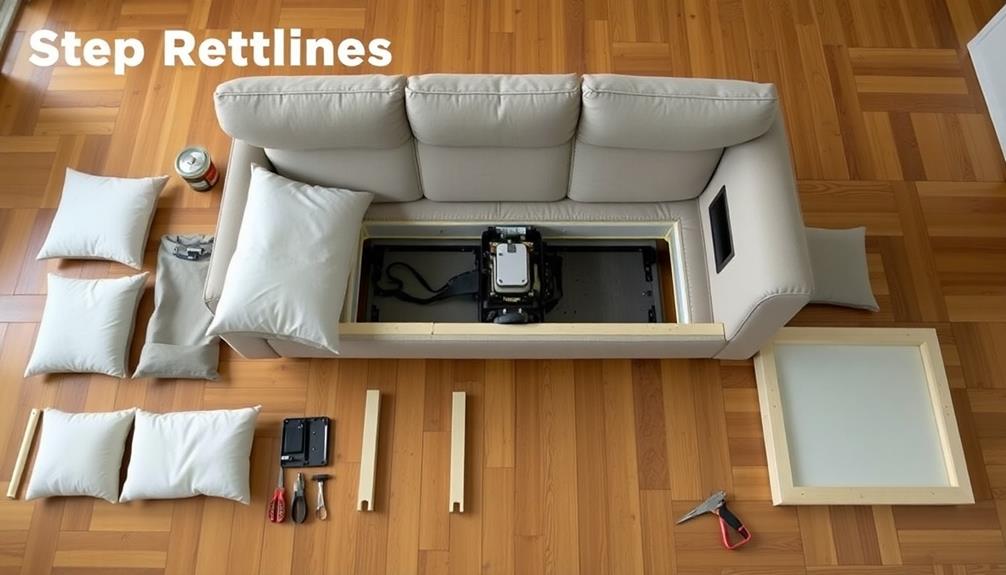In order to ensure that restroom accessibility is effective, it is important to adhere to the necessary ADA toilet dimensions. The rough-in measurement should be a minimum of 18 inches from the wall to the center of the toilet flange. Aim for a toilet seat height of 17 to 19 inches for comfort and ease of use. Additionally, a clear floor space of at least 60 inches in diameter is required for wheelchair maneuverability. It is crucial to install grab bars at a height of 33 to 36 inches for extra support. By focusing on these dimensions, a more accessible environment can be created. There is much more to learn about optimizing restroom accessibility.
Key Takeaways
- The rough-in measurement must be at least 18 inches from the wall to the center of the toilet flange for accessibility.
- Toilet seat height should range between 17 to 19 inches above the finished floor for user comfort.
- A clear floor space of at least 60 inches in diameter is required for wheelchair maneuverability.
- Grab bars must be installed 33-36 inches above the floor to provide effective support for users.
- Regular maintenance and inspections ensure ongoing compliance with ADA accessibility standards.
Understanding ADA Compliance
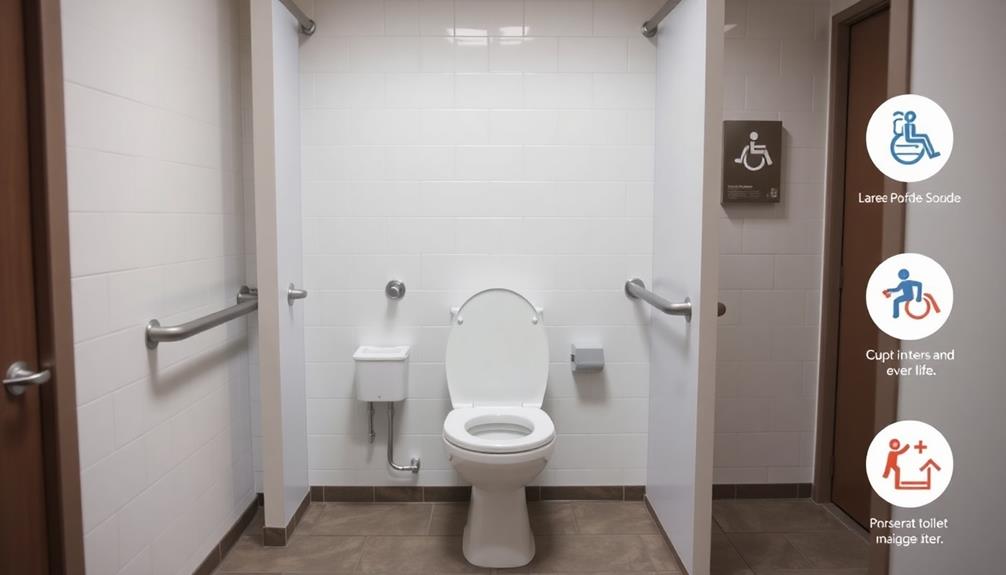
Understanding ADA compliance is essential for guaranteeing that restrooms are accessible to everyone, especially individuals with disabilities. You need to familiarize yourself with the key requirements, such as the rough-in measurement of at least 18 inches from the wall to the toilet flange.
The seat height should be between 17 to 19 inches above the finished floor, providing comfort and ease of use. Grab bars must be properly placed for support, and toilet paper dispensers should meet specific height and reach guidelines.
Thoughtful planning of the restroom's layout will guarantee unobstructed access for individuals using mobility aids. By adhering to these ADA standards, you can create an inclusive environment that benefits all users, enhancing their overall restroom experience.
Key Toilet Dimensions
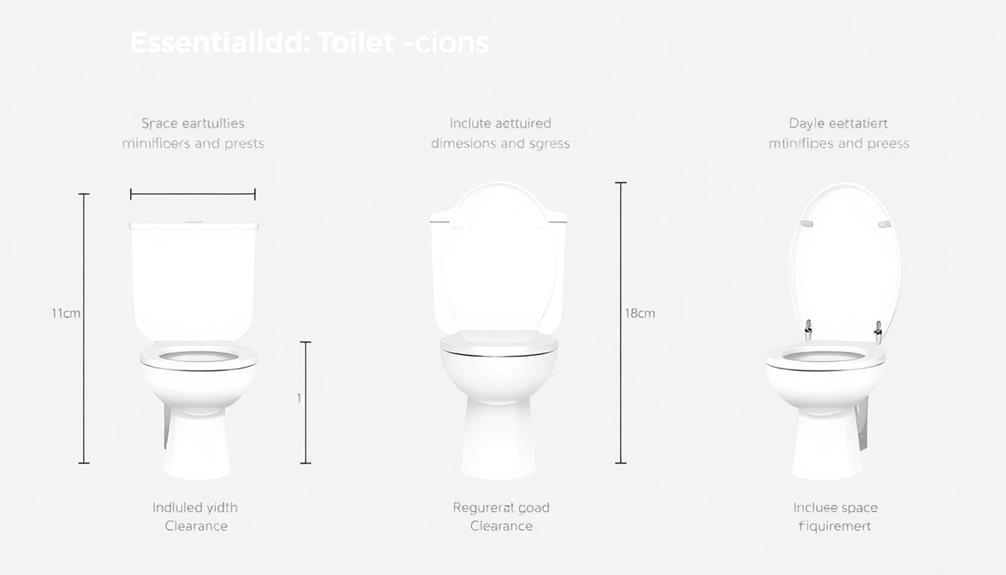
When it comes to ADA compliance, knowing the key toilet dimensions is essential for creating accessible restrooms.
First, verify the rough-in measurement is at least 18 inches from the wall to the center of the toilet flange.
Next, the toilet seat height should be between 17 to 19 inches above the finished floor for ideal accessibility.
Additionally, consider the space around the toilet; you'll need a clear floor area of at least 60 inches in diameter to allow for wheelchair maneuverability.
Also, make certain grab bars are installed according to ADA guidelines to provide necessary support.
Installation Considerations
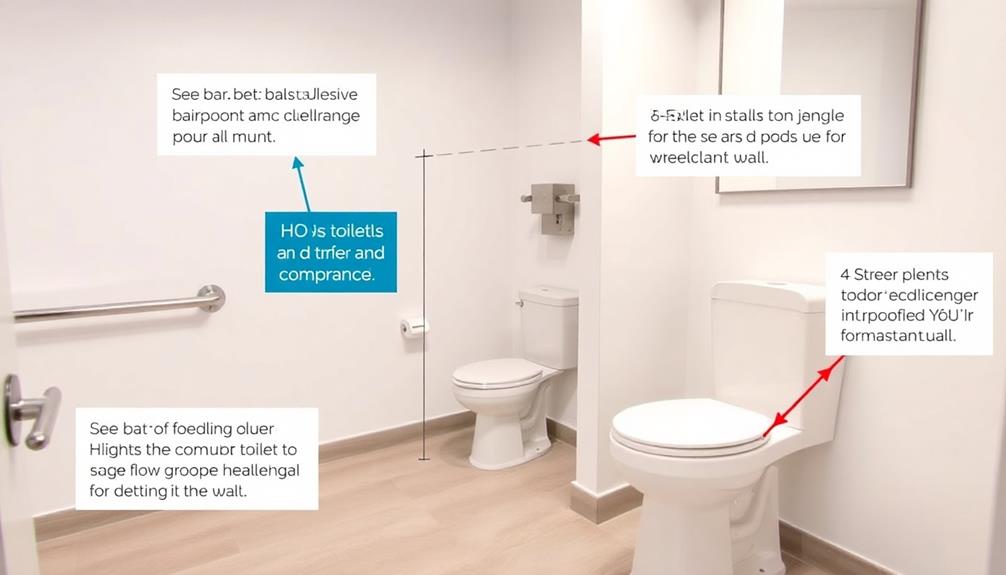
Ensuring proper installation is essential for creating an ADA-compliant restroom. You'll need to evaluate factors like grab bar placement, toilet seat height, and clear floor space for wheelchair access. Be aware that space constraints and existing plumbing can complicate your installation. Here's a table to help you visualize key installation considerations:
| Feature | Recommended Measurement | Compliance Importance |
|---|---|---|
| Toilet Height | 17-19 inches | Accessibility for users |
| Grab Bar Height | 33-36 inches above floor | Support for transfer |
| Clear Floor Space | 60 inches minimum width | Maneuverability for wheelchairs |
| Toilet Paper Dispenser | 15-48 inches from floor | Easy access for all users |
| Rough-in Measurement | 18 inches from wall | Proper alignment and function |
Selecting Accessible Toilets
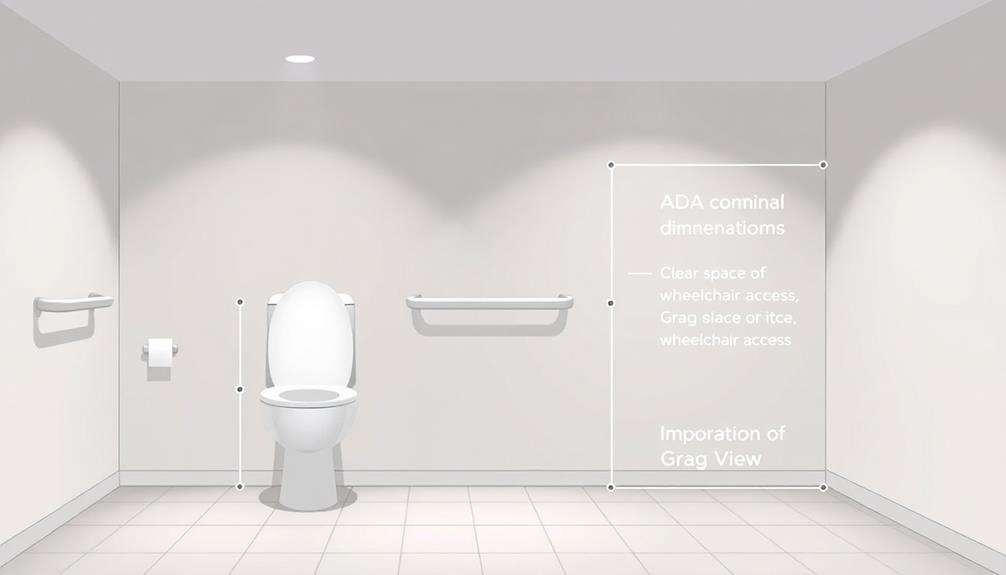
Choosing the right toilet for an accessible restroom can greatly impact user comfort and functionality. Start by evaluating the technical requirements and specific user needs.
Consider different styles, such as one-piece, two-piece, or wall-mounted toilets; each has its own advantages depending on your space. Look for toilets with the WaterSense label to prioritize water efficiency.
Make sure the toilet seat height falls between 17 to 19 inches for maximum accessibility. Additionally, think about the placement of grab bars and the overall layout—clear floor space is essential for users with mobility aids.
Balancing style and functionality will help you create a restroom that meets ADA compliance while catering to all users effectively.
Enhancing User Comfort
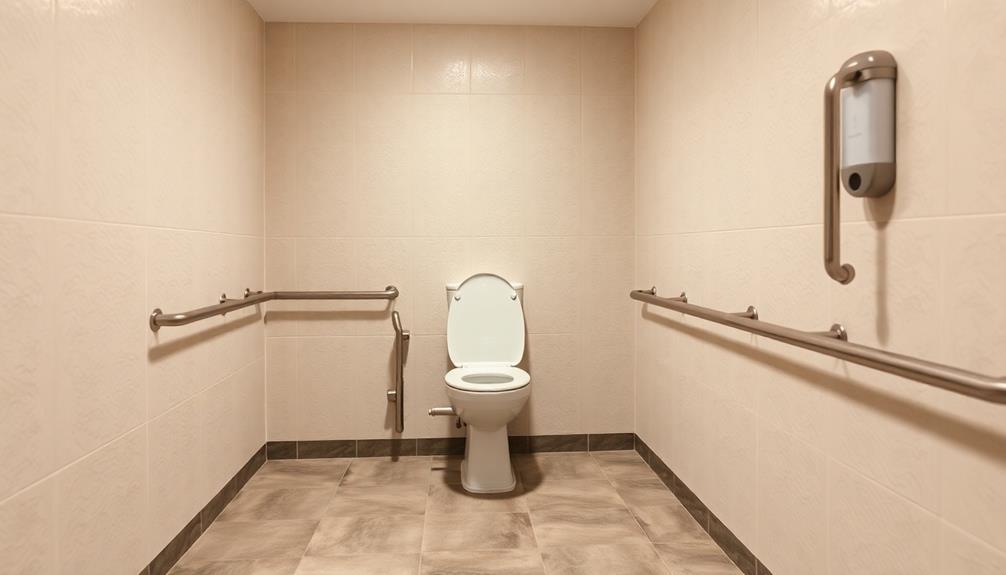
Enhancing user comfort in accessible restrooms is vital for creating a positive experience for individuals with mobility challenges. To achieve this, consider incorporating grab bars and elevated toilet seats, which provide additional safety and support.
Opt for toilets designed with ergonomic seating heights to facilitate easier transfers from mobility aids. Guarantee there's ample space around the toilet for maneuverability, allowing users to position themselves comfortably.
User feedback plays an important role in refining the restroom experience, so actively seek input on design and functionality.
Importance of Rough-In Measurements
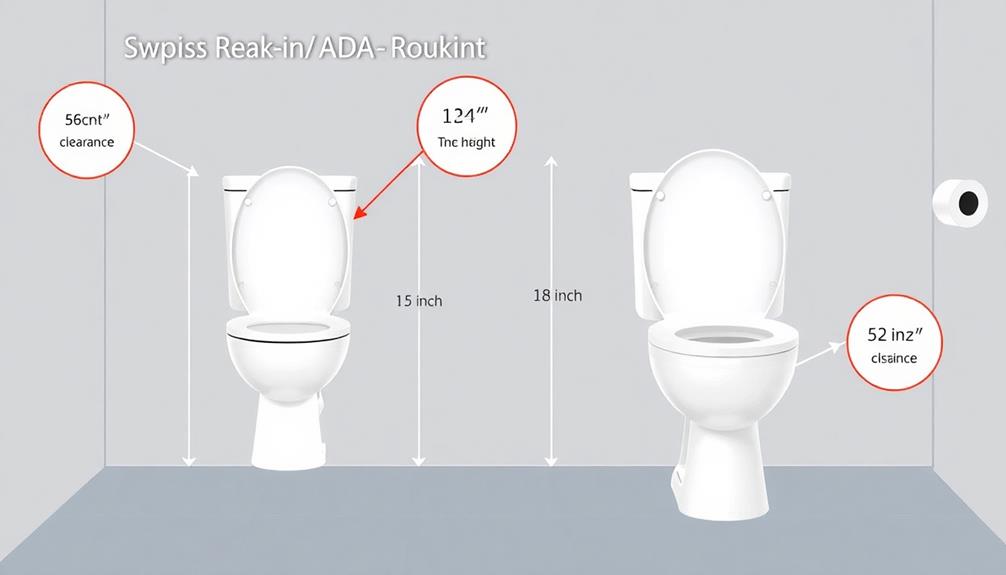
Understanding the importance of rough-in measurements is crucial for successful ADA toilet installations.
These measurements determine the distance from the wall to the center of the toilet flange, which must be at least 18 inches for ideal accessibility. If you don't get this right, you risk creating a space that's difficult for users with mobility challenges.
Accurate rough-in dimensions guarantee that the toilet is positioned correctly, allowing enough clearance for wheelchairs and other mobility aids. It also helps in avoiding plumbing issues and guarantees that fixtures like grab bars can be installed properly.
Ultimately, precise rough-in measurements are essential for providing a safe, comfortable, and compliant restroom experience for everyone.
Don't underestimate their significance!
Maintenance and Compliance Tips
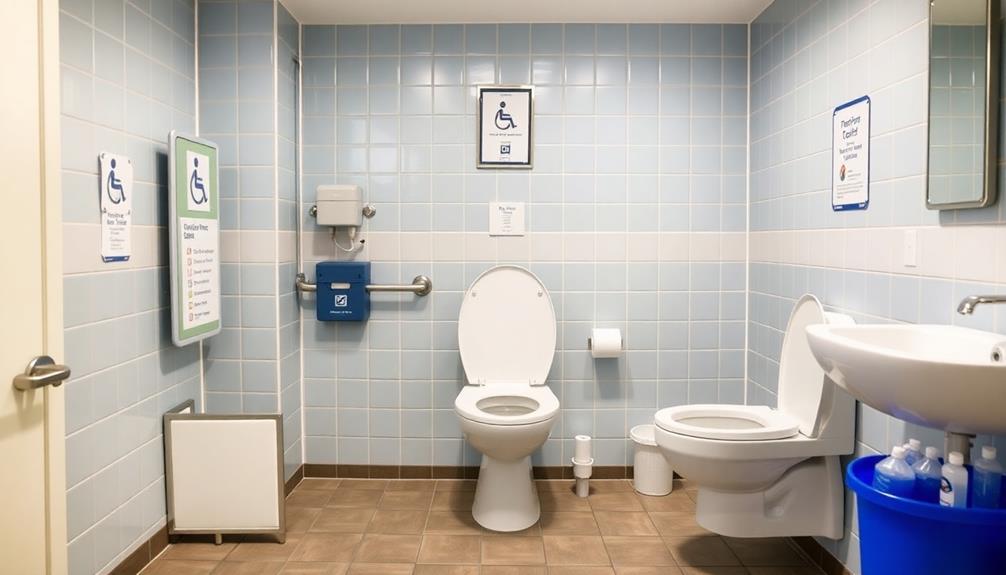
Accurate rough-in measurements set the foundation for a compliant and user-friendly restroom, but regular maintenance is just as important for guaranteeing ongoing accessibility.
To maintain compliance, routinely check grab bars and toilet fixtures for stability and wear. Ascertain that toilet paper dispensers and hand dryers remain at ADA-approved heights and are stocked for user convenience.
Conduct regular inspections of the restroom space to confirm clear pathways, free from obstructions. Address plumbing issues immediately to prevent disruptions in service.
Also, gather user feedback to identify areas needing improvement. By prioritizing maintenance and compliance, you'll create a safe, accessible environment for everyone, fostering inclusivity and support for individuals with disabilities. Additionally, implementing clear policies, such as keeping dogs away from furniture, can help maintain cleanliness and ensure comfort for all users. This attention to both user preferences and practical guidelines enhances the overall experience for everyone, contributing to a welcoming and well-organized space. Regularly reviewing these practices ensures ongoing improvements that align with community needs. Moreover, offering resources on topics like **how to train dogs off furniture** can further support users in managing their pets while maintaining the desired environment. Encouraging responsible pet ownership not only helps in preserving the cleanliness and functionality of shared spaces but also strengthens the sense of community by respecting everyone’s comfort. By continuously adapting to evolving user feedback and practical needs, you can create a harmonious and well-maintained atmosphere that everyone can enjoy.
Frequently Asked Questions
What Are the Penalties for Non-Compliance With ADA Toilet Regulations?
If you don't comply with ADA toilet regulations, you could face legal penalties, including fines and lawsuits. Ensuring accessibility not only helps you avoid these issues but also supports individuals with disabilities in your facilities.
How Can I Find a Certified ADA Compliance Contractor?
Did you know that over 61 million adults in the U.S. live with a disability? To find a certified ADA compliance contractor, search online directories, ask for referrals, and verify they have relevant experience and credentials.
Are There Grants Available for ADA Bathroom Renovations?
Yes, there are grants available for ADA bathroom renovations. You should explore local, state, and federal programs dedicated to improving accessibility. Researching these options can help you secure funding for your project effectively.
What Materials Are Recommended for Ada-Compliant Restroom Surfaces?
Did you know that over 61 million adults in the U.S. live with disabilities? When selecting materials for ADA-compliant restrooms, prioritize non-slip surfaces, durable finishes, and easy-to-clean options to enhance safety and accessibility.
How Often Should Ada-Compliant Toilets Be Inspected for Maintenance?
You should inspect ADA-compliant toilets regularly, ideally every month. Check for proper functioning, cleanliness, and any wear or damage. Consistent maintenance guarantees the restroom remains safe and accessible for everyone who uses it.
Conclusion
Incorporating essential ADA toilet dimensions isn't just about compliance; it's about creating a welcoming space for everyone. For instance, imagine a family visiting a restaurant where the restroom features accessible toilets with proper grab bars and seat heights. This thoughtful design allows a grandmother with mobility challenges to feel independent and comfortable. By prioritizing accessibility, you promote dignity and inclusivity, ensuring all visitors can enjoy your facilities without barriers.
